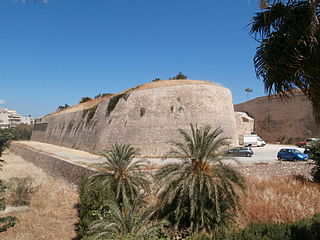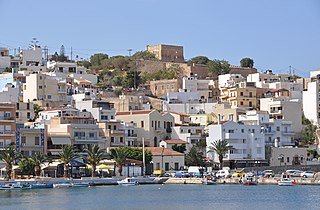 W
WThe fortifications of Chania are a series of defensive walls and other fortifications which surround the city of Chania in Crete, Greece. The inner city walls were first built in antiquity, and were rebuilt by the Byzantine Empire. The outer walls were built in the 16th century by the Republic of Venice. Some of the fortifications were demolished in the 20th century, but parts of both the Byzantine and Venetian walls remain intact.
 W
WThe Fortezza is the citadel of the city of Rethymno in Crete, Greece. It was built by the Venetians in the 16th century, and was captured by the Ottomans in 1646. By the early 20th century, many houses were built within the citadel. These were demolished after World War II, leaving only a few historic buildings within the Fortezza. Today, the citadel is in good condition and is open to the public.
 W
WFrangokastello is the location of a castle and scattered settlement on the south coast of Crete, Greece, about 12 km east of Chora Sfakion and within the prefecture of Chania.
 W
WGramvousa also Grampousa refers to two small uninhabited islands off the coast of a peninsula also known Gramvousa Peninsula in north-western Crete in the regional unit of Chania. The Gramvousa Peninsula forms the westernmost of the two pairs of peninsulae in north-western Crete and is the western part of Kissamos Bay.
 W
WThe fortifications of Heraklion are a series of defensive walls and other fortifications which surround the city of Heraklion in Crete, Greece. The first city walls were built in the Middle Ages, but they were completely rebuilt by the Republic of Venice. The fortifications managed to withstand the second longest siege in history for 21 years, before the city fell to the Ottomans in 1669.
 W
WKazarma is the Venetian-era fortress of the city of Sitia in Crete, Greece. This fortress was built in the 13th Century during Venetian rule on Crete. The Venetians abandoned the town in 1651 and destroyed parts of the fortress to prevent its use by the Turks.
 W
WThe Koules or Castello a Mare is a fortress located at the entrance of the old port of Heraklion, Crete, Greece. It was built by the Republic of Venice in the early 16th century, and is still in good condition today.
 W
WPalaiokastro is a coastal village and a community in the municipal unit of Malevizi. 9 km west of Heraklion on the island of Crete. In 2011 Palaiokastro had a population of 255 for the village and over 1000 of people that have their country house. It is situated in front of a 70 meter long pebbled beach leading to a cove with rapidly deepening waters that are protected from the prevailing northerly winds. On the southern end of the beach rises a steep calcareous rock. During the Venetian occupation of Crete extensive fortifications were built on this rock, housing cannons that secured the bay of Heraklion. Ruins of the fortress walls survive until today.
 W
WSouda is an islet in Souda Bay on the northwest coast of Crete. In ancient times this islet was one of two islets that were referred to as Leukai. The second islet is known today as Leon.
 W
WSpinalonga is an island located in the Gulf of Elounda in north-eastern Crete, in Lasithi, next to the town of Plaka. The island is further assigned to the area of Kalydon. It is near the Spinalonga peninsula – which often causes confusion as the same name is used for both. The official Greek name of the island today is Kalydon.